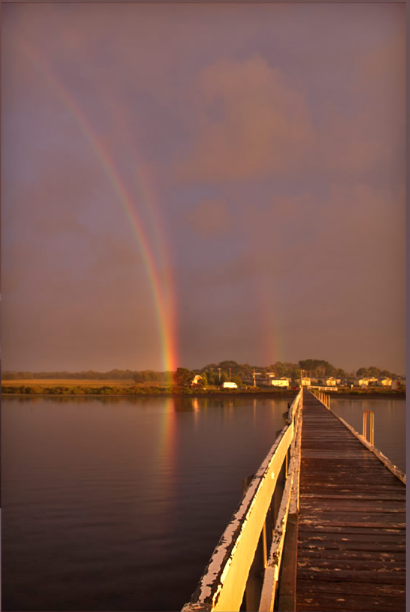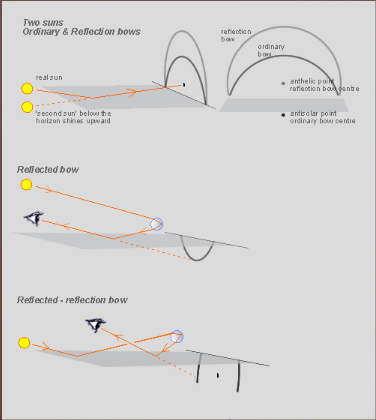OPOD - Multiple Bows
OPOD - Multiple Bows: A Fascinating Atmospheric Phenomenon
Have you ever witnessed the mesmerizing sight of multiple bows adorning the sky? This captivating atmospheric optics phenomenon, known as multiple bows, occurs when sunlight interacts with water droplets in the air. While rainbows are a familiar sight to many, multiple bows take this enchanting display to another level. In this article, we will delve into the intricacies of multiple bows and explore the science behind their formation.
Multiple bows are often observed in specific atmospheric conditions, such as when the sun is low on the horizon, shortly after sunrise or before sunset. During these times, sunlight must travel through a larger portion of Earth's atmosphere, leading to greater scattering and the formation of more intricate optical phenomena.
When sunlight encounters water droplets in the air, it undergoes various processes, including refraction, reflection, and dispersion. These interactions give rise to the primary and secondary rainbows that we commonly observe. However, in the case of multiple bows, additional reflections and refractions occur due to the presence of reflective surfaces like smooth lakes or seas.
Imagine a scenario where the sun is low on the horizon, casting its rays onto a calm body of water with a mirror-like surface. In this situation, the water acts as a reflective surface, effectively creating two "suns." Each "sun" generates its own set of rainbows, resulting in a fascinating overlap of multiple bows. The rays from the reflected sun travel upwards and form rainbows whose centers are above the horizon. These rainbows intersect at the horizon, creating a captivating visual spectacle.
The lower portion of multiple bows is formed by sunlight reflecting off the water surface and then interacting with raindrops. This interaction leads to the formation of what is known as a "reflected bow." Additionally, sunlight can undergo multiple reflections before and after reaching a raindrop, resulting in a "reflected-reflection bow." These intricate ray paths contribute to the unique appearance of the rainbows below the horizon.
It's important to note that the center of a rainbow is always directly opposite the sun and lies below the horizon. This positioning is crucial in understanding the formation of multiple bows. The overlapping rainbows above and below the horizon create a captivating display of colors and patterns, offering a truly awe-inspiring experience for those fortunate enough to witness it.
The phenomenon of multiple bows showcases the intricate interplay between sunlight, water droplets, and reflective surfaces. It serves as a reminder of the remarkable beauty and complexity of our natural world. While multiple bows may not be as commonly observed as their single counterparts, they offer a unique and enchanting spectacle that continues to captivate scientists and nature enthusiasts alike.
In conclusion, multiple bows are a captivating atmospheric optics phenomenon that occurs when sunlight interacts with water droplets in the air, particularly in the presence of reflective surfaces like smooth lakes or seas. The overlapping rainbows above and below the horizon create a stunning display of colors and patterns, making multiple bows a truly mesmerizing sight. So, keep your eyes to the sky during those magical moments when the sun is low, and you may be lucky enough to witness this extraordinary atmospheric phenomenon firsthand.

Top: Images were taken a few minutes after sunrise. Each end of the reddened primary is doubled. The doubled bows meet at the horizon and separate upwards and downwards. Image enhancement shows the secondary also doubled.
Below: Forty minutes later, doubled bows form a cross.

Reflection Bows
Imaged by Phil Thomson at Swan Bay, near Queenscliff in Victoria, Australia.
©Phil Thomson


The centre of a rainbow is always directly opposite the sun and therefore below the horizon.
Now imagine a low sun reflected by the mirror-like surface of a smooth lake or sea. In effect, there are then two suns and these can form two sets of rainbows. Rays from the reflected sun travel upwards and form rainbows whose centre is above the horizon. The rainbows from the two suns cross at the horizon.
The rainbows below the horizon are produced by more contorted ray paths. Sunlight from the raindrops reflects from the water (reflected bow) or is reflected before and after it reaches a raindrop (reflected-reflection bow). The ray paths are perhaps easier to remember than their names!
Note: this article has been automatically converted from the old site and may not appear as intended. You can find the original article here.
Reference Atmospheric Optics
If you use any of the definitions, information, or data presented on Atmospheric Optics, please copy the link or reference below to properly credit us as the reference source. Thank you!
-
<a href="https://atoptics.co.uk/blog/opod-multiple-bows/">OPOD - Multiple Bows</a>
-
"OPOD - Multiple Bows". Atmospheric Optics. Accessed on November 26, 2024. https://atoptics.co.uk/blog/opod-multiple-bows/.
-
"OPOD - Multiple Bows". Atmospheric Optics, https://atoptics.co.uk/blog/opod-multiple-bows/. Accessed 26 November, 2024
-
OPOD - Multiple Bows. Atmospheric Optics. Retrieved from https://atoptics.co.uk/blog/opod-multiple-bows/.